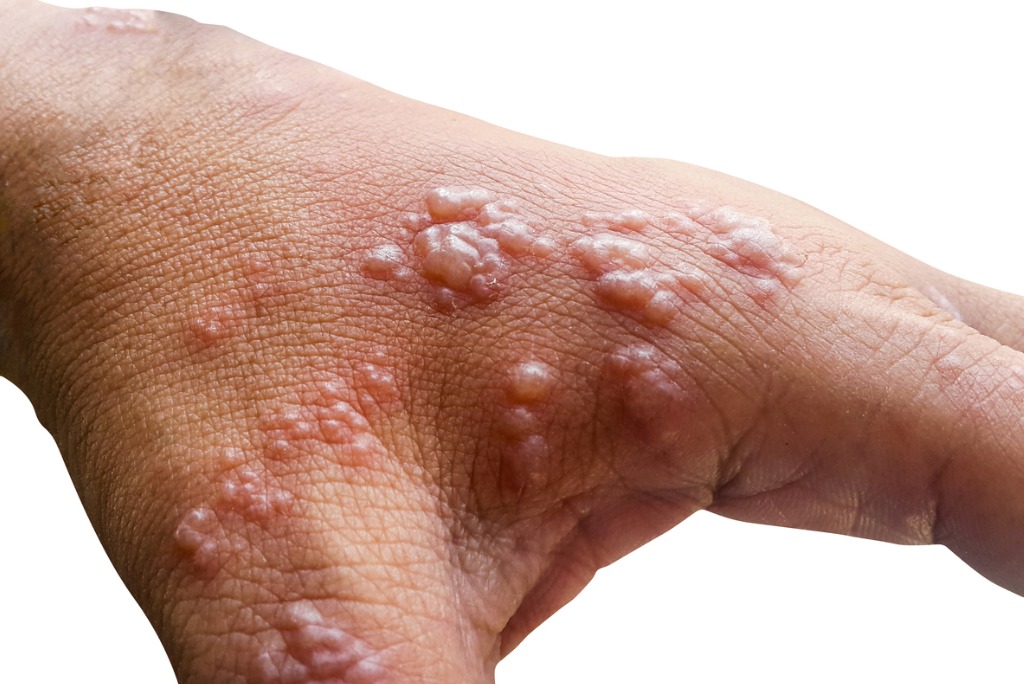Bullous pemphigoid is a rare, autoimmune skin condition that forms large, fluid-filled blisters. The blisters typically form on the outermost layer of skin (the epidermis) and may occur anywhere on the body. However, they most commonly appear on the belly, chest, legs, arms, groin, or armpits.
Although this disease is estimated to affect less than 50,000 Americans, it may be life-threatening, especially for people who are already in poor health. Therefore, if you or a loved one is dealing with this rare condition, it’s essential to educate yourself about the condition and its potential treatments. The more you know, the better equipped you’ll be to make informed decisions about your care.
Bullous Pemphigoid Risk Factors and Causes
This condition is thought to result from the immune system mistakenly attacking a thin layer of tissue below the outer layer of your skin. It’s not clear what causes this to happen, but there are some risk factors that may increase your chances of developing bullous pemphigoid. For example, those between 60 to 80 years of age are more likely to develop the condition. Children may also develop bullous pemphigoid, but this is much less common.
Other risk factors include:
- UV radiation exposure
- Certain medications, such as penicillin
- Radiation therapy
- Burns or other injuries to the skin
- Neurological conditions, such as Parkinson’s disease or epilepsy
To diagnose bullous pemphigoid, your doctor may order a blood test and take a skin biopsy. You may be referred to a dermatologist or other specialist, depending on the severity of your symptoms and your test results.
Symptoms of Bullous Pemphigoid
The symptoms of this rare skin condition may range from mild to severe and often resolve on their own within a few months. However, it is possible for symptoms to take as long as five years to subside. The disease sometimes goes into remission, only to return later — this is especially common once treatment is stopped.
Symptoms of bullous pemphigoid may include:
- Itchy skin weeks or months before the development of blisters
- Large blisters that typically form along fold lines in the skin
- Eczema or hives
- Small blisters or sores in the mouth
If you notice unexplained blisters on your skin, around your eyes, or in your mouth, you may have bullous pemphigoid. Additionally, if you start to see signs of an infection, such as a fever, redness, swelling, or pus, seek medical attention immediately, as bullous pemphigoid may lead to life-threatening complications.
Ways to Find Relief from Bullous Pemphigoid
Although there is currently no known cure for bullous pemphigoid, there are ways to find relief. Treatments are often aimed at relieving itchy skin and healing blisters and sores. Treating the condition may require a few lifestyle changes, such as:
- Limiting activities that worsen your blisters
- Avoiding sun exposure
- Wearing loose-fitting clothing
- Using mild soaps and detergents
- Taking care of blisters and open wounds to prevent infection
In addition to making lifestyle changes and taking extra care of your skin, you may also be prescribed medication to manage your symptoms. Commonly prescribed medications include corticosteroids such as oral prednisone or a corticosteroid ointment that may be rubbed directly onto the skin to provide relief.
Immunosuppressive therapy may also be used to treat bullous pemphigoid. This therapy uses drugs such as azathioprine to suppress your body’s immune response. Immunosuppressive therapy is typically only used when other treatments haven’t worked or your symptoms are severe.
Change Your Outlook with Olympian Clinical Research
If you’re struggling to find relief or your symptoms are severe, know that you’re not alone. At Olympian Clinical Research, we are dedicated to helping those with bullous pemphigoid and other rare conditions through clinical research trials. We believe everyone deserves access to the latest advancements in treatment and care, and our team is committed to providing that access to our patients.
Through clinical research trials, you may have access to novel treatments and therapies not available anywhere else, giving you the hope of a better tomorrow. If you’re interested in learning more about how you may participate in a clinical research trial, contact us today. We’ll work with you to answer any questions and help you get started on the path to changing your outlook for the future.

Recent Comments